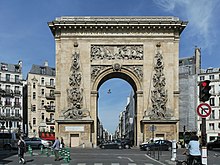| This article does not cite any sources. Please help improve this article by adding citations to reliable sources. Unsourced material may be challenged and removed. Find sources: "City gates of Paris" – news · newspapers · books · scholar · JSTOR (March 2014) (Learn how and when to remove this message) |

While Paris is encircled by the Boulevard Périphérique (Paris ring road), the city gates of Paris (French: portes de Paris) are the access points to the city for pedestrians and other road users. As Paris has had successive ring roads through the centuries, city gates are found inside the modern-day Paris.
The city gates of today

(List of city gates created during the extension of Paris in 1860 and which have left their mark on the city map. The gates are listed in clockwise sequence starting in the north at la Route Nationale 1.)
North-east
18e est
19e
- Porte d'Aubervilliers : route nationale 301
- Porte de la Villette : route nationale 2
- Porte de Pantin : route nationale 3
- Porte Chaumont
- Porte Brunet
- Porte du Pré-Saint-Gervais
- Porte des Lilas
East
20e
- Porte des Lilas
- Porte de Ménilmontant
- Porte de Bagnolet : autoroute A3
- Porte de Montreuil : route nationale 302
12e
- Porte de Vincennes : route nationale 34
- Porte Jaune
- Porte de Saint-Mandé
- Porte de Montempoivre
- Porte Dorée or "Porte de Picpus"
- Porte de Reuilly
- Porte de Charenton : route nationale 6
- Porte de Bercy : autoroute A4
South (rive gauche)
13e
- Porte de la Gare
- Porte de Vitry
- Porte d'Ivry
- Porte de Choisy : route nationale 305
- Porte d'Italie : route nationale 7
- Poterne des Peupliers
14e
- Porte de Gentilly
- Porte d'Arcueil
- Porte d'Orléans : route nationale 20
- Porte de Montrouge
- Porte de Châtillon
- Porte Didot
- Porte de Vanves
15e
- Porte Brancion
- Porte de Plaisance
- Porte de la Plaine
- Porte de Versailles
- Porte d'Issy
- Porte de Sèvres
West
16e
- Porte du Point-du-Jour
- Porte de Saint-Cloud : route nationale 10
- Porte Molitor
- Porte de Boulogne
- Porte de l'Hippodrome
- Porte d'Auteuil : autoroute A13
- Porte de Passy
- Porte de la Muette
- Porte Dauphine
- Porte de la Seine
- Porte de Madrid
- Porte Saint-James
- Porte de Neuilly
- Porte des Sablons
North-west
17e
- Porte Maillot : route nationale 13
- Porte des Ternes
- Porte de Villiers
- Porte de Champerret
- Porte de Courcelles
- Porte d'Asnières
- Porte de Clichy
- Porte Pouchet
18e
- Porte de Saint-Ouen
- Porte de Montmartre
- Porte de Clignancourt : route nationale 14
- Porte des Poissonniers
Ancient gates of Paris


- Porte Saint-Denis along the trace of the enceinte of Charles V.
- Porte Saint-Martin along the trace of the enceinte of Charles V.
- Rue des Fossés-Saint-Bernard
- Rue des Fossés-Saint-Jacques
- Rue des Fossés-Saint-Marcel
After the construction of the Wall of the Farmers-General in 1785, the gates of Paris bore the names barriers (barrières) until 1860 (e.g. barrière de la Villette, barrière du Trône, barrière d'Italie, etc.) They were, in fact, toll gates used for collection of the octroi, an excise tax assessed on goods entering the city. Some of the toll booths built by Ledoux remain at:
- rotunda of the Place de Stalingrad
- Place du Trône
- Place Denfert-Rochereau (formerly barrière d'Enfer)